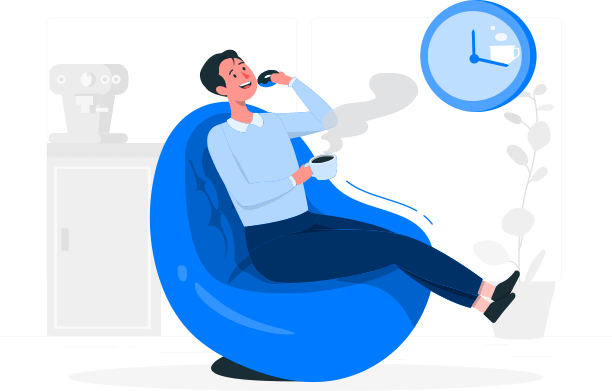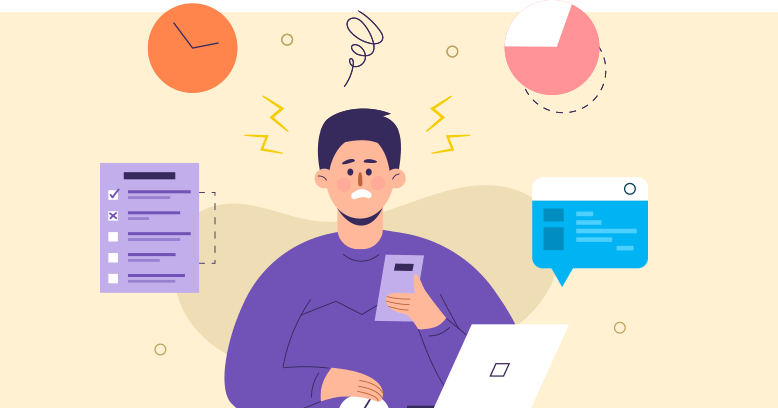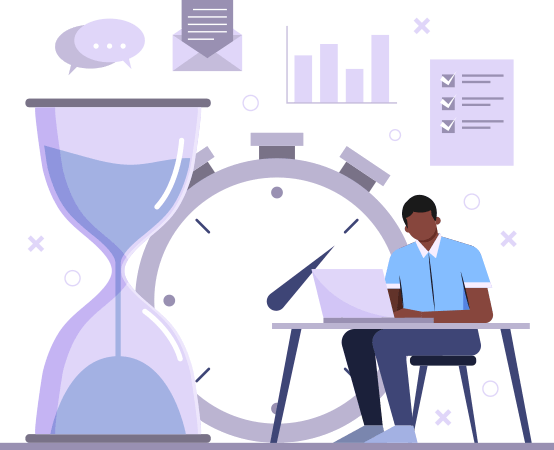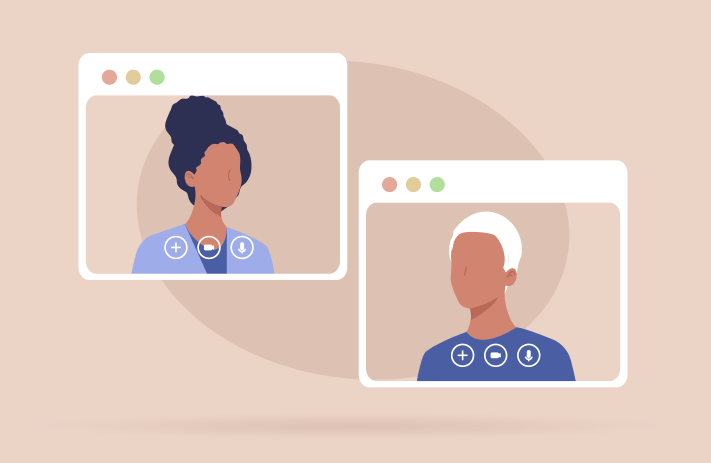
Click the button to start reading
8 Easy Ways to Increase Focus at Work (and reduce stress!)
If there was a way to increase your focus at work, how big of a difference would it make to your productivity during the workday?
Think about it. How often do you find yourself dead center in the middle of an intense work period, when suddenly, your phone goes off or your email dings and that iron-clad focus vanishes into thin air…and becomes increasingly harder to find post distraction?
It’s something we’ve all experienced at one time or another, and it can have a heavy impact on productivity and stress levels throughout your working hours.
Losing focus can happen in an instant, and though it can seem like “no-big-deal” in that moment, it can make a big difference over time. Focus is a skill that’s developed through intentional habits. Most people aren’t naturally born with the ability to direct their attention towards one thing for long periods of time. Pair that with our high-tech world that thrives on the need for instant gratification stemming from our use of the internet (especially from social media), and it’s only natural we’d now find it difficult to concentrate on one specific task for a set amount of time.
2 Main Factors That Affect Your Focus At Work
Our ability to focus at work can be influenced by a number of factors, however, they nearly always fall into one of two categories: environmental and personal.
Environmental
Environmental factors are those that make up the physical and social environment around you. These include the state of your workspace, the people around you, external events (meetings, presentations, workplace events, etc), and the technological distractions you experience, such as your phone or computer. Though not all these aspects are fully within your control, they can often be planned for in advance.
Personal
Personal factors are directly related to you as an individual. Some examples of personal factors that affect focus include your current emotional state, attention inhibiting diagnosis (ex. ADHD), negative or positive self-talk, personality type, and work style. All these things are individual to you and can be developed and strengthened over time to help improve your mental clarity and focus.

8 Ways To Increase Focus At Work
Increasing focus in the workplace is a skill that will take time to develop. When you take action to plan for and manage the distractions you face throughout your workday, you’ll find higher levels of concentration beginning to form, while also increasing productivity and reducing stress in the workplace!
Here are our top 8 ways to increase your focus at work:
1. Organize Your Workspace
Organization in the workplace helps set you up for success by making your workspace predictable and easy to manage. Predictability in the workplace boosts focus by removing the obstacles, which allows you to efficiently move throughout your tasks without getting distracted by something you saw or another task you had out on your desk.
2. Create A Daily Schedule (and follow it!)
Often, we create a weekly work plan without thinking twice about making it smaller and more digestible. When you break your week down and create a schedule for each day, you’re able to dial in the efficiency of your workday and promote productivity. This also gives you the freedom to create a schedule that works best for you and your internal clock. If you focus better in the morning, plan for your uninterrupted work to be done during the first portion of the day while giving yourself permission to take several breaks in the afternoon while completing your less intensive tasks (or vice versa). Another way to optimize your daily schedule is to switch between tasks that require low levels of attention and those that need higher amounts. This will naturally provide your brain with time to rest between the more demanding tasks.

3. Take Breaks
Breaks are essential to productivity and focus. If you go without taking breaks throughout the day, you’ll often find yourself suffering from high levels of mental fatigue and foggy processing. The longer you go without a break, the more likely it is for the quality of your work to decrease. Giving your mind time to recoup at regular intervals will not only lead to greater focus during working periods but it’ll also provide you with a moment to gain some perspective when working through a particularly challenging project.
4. Eliminate Distractions
In a workplace where we’re surrounded by technology, distractions are common. Create uninterrupted working periods by setting your phone to ‘do not disturb’, muting your desktop notifications, and silencing anything else that will steal your attention if alerts go off. If you have an office, you can even put a ‘Do Not Disturb’ sign on your door to keep colleagues from disrupting you during your working periods.

5. Avoid Multitasking
When you split your attention into multiple tasks, you’re never fully investing yourself into one singular activity and can distract yourself from the others when one gets challenging. Often, this leads to less work being completed and makes for a more stressful work environment because it creates the illusion that you’re much busier than you actually are. In fact, in a Stanford University study on multitasking, researchers found that habitual multitaskers appeared to struggle with navigating among multiple threads of information, while also being less able to filter out distractions and focus on material that was highly relevant to their end goal.
6. Use A Timer
If you catch yourself checking the clock constantly throughout the day, use a timer to help you remove the anxiety or stress surrounding how fast (or slow) time is going. When you incorporate a timer as part of your work routine (like the pomodoro method), you’re effectively supporting your uninterrupted working time in 2 specific ways…
First, you’re allowing your brain to naturally shift into work mode due to the specific window of time you’ve given yourself to complete the task.
Secondly, it will reduce the desire to look at the clock as there is no anxiety surrounding time because you’ve already determined and set an end time to the work period, effectively making it a predictable and measurable portion of your workday.
7. Respond To Your Brains Cues
If you catch yourself stuck on a difficult aspect of your task, or if you’re finding you’ve lost the flow of your process with no sense of end in sight, try switching to another task that has a high potential for successful completion. Give your mind a break and reinforce your confidence by checking off another item on your list. Quick wins and small rewards are great tools to help you combat resistance and motivate you to return to the original task with a better mindset.
8. Find Your Individual Working Style (and plan accordingly!)
Everyone requires different things to help them focus and move through their workday with success. Consider the following:
- Do you find rewards appealing? Consider adding them into your day to encourage task completion.
- Do you need to pre-plan your task to feel confident enough to take it on? Get all your notes in order and make a basic outline to reference as you move through it.
- Do you need to chunk your work into smaller (or larger) portions? If you’re a person who needs frequent breaks, split your tasks into smaller portions that are easier for you to digest without becoming overwhelmed. If you’re a person who needs to go through a task from start to finish in one sitting to maintain your focus, plan for longer breaks at the end of each task.
- Do you need silence when you work, or does music help you concentrate? If you need it to be silent, make a plan for how you can achieve that taking your current work environment into consideration. Do you need noise-canceling headphones? Is there a specific playlist that helps you focus (instrumentals or soft white noise?)
- Do you need more uninterrupted time to work through those more intense objectives, but have a busy office and colleagues that love to stop by for chats? Consider adding a sign on your door to keep people from interrupting, or have a visual schedule for your colleagues to know when you’re available.
This can be digital, like a shared calendar with unavailable times marked, or a physical one by your office space.
Consider what supports your concentration and build it into your work environment.

Conclusion
Focus is a skill that can be developed with the right knowledge. When it’s missing from your work habits, it can reduce productivity, create a more stressful environment, and leave you feeling exhausted (and potentially behind schedule) at the end of each workday.
When you include windows of time each day where you are completely focused, you are naturally building up your mind’s tolerance to distractions and strengthening your ability to concentrate and stay on task for longer periods of time.
Evaluate your work habits, consider what you need to help increase your focus at work, and implement it one step at a time.
















